�
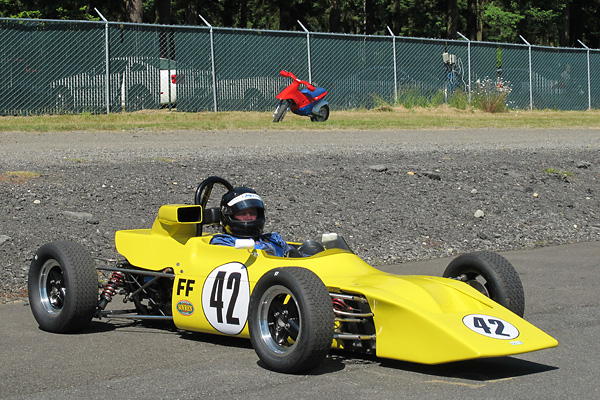
�
�
Jim Johnson's 1972 March 729 Formula Ford Race Car
� � Owner: Jim Johnson� City: Woodinville, Washington
� Model: 1972 March 729
� Engine: Ford 1600cc four cylinder
� Race prepared by: owner.�
�
March Engineering Limited
��
At the youthful age of 26 years, Robin Herd resigned from a safe career at National Gas Turbines and�
joined McLaren as Chief Designer, where he would work on Formula One and Can-Am cars just as�
McLaren was becoming a leading player. Somehow though, McLaren didn't keep Herd busy enough,�
and he made time for occasional side projects designing this and that for other racing outfits. He�
dreamed of really focusing his considerable talents on designing Formula One cars. By 1969, Herd�
was looking to move on and was exploring possibilities with an old school chum named Alan Rees�
who had managed Winkelmann Racing in close association with Lotus. Rees brought along another�
friend with automotive parts production experience, by the name of Graham Coaker. Rees imagined�
managing a Formula One team; Coaker dreamed of managing the construction of racecars. At about�
the same time, while working on a design modification to Piers Courage's Tasman Series car, Robin�
became reacquainted with an old Oxford classmate named Max Mosley. Mosley was a barrister�
turned serious-amateur driver. (He had the advantage of a moneyed background.) Mosley dreamed�
about all the fun he could have arranging sponsorships and business deals. One thing led to another,�
and before long Mosley, Alan Rees, Coaker and Herd merged their names and became "March".�
�
March called their first car the "693". Their model numbering system was simple enough to understand:�
it was a Formula Three car for the 1969 season. Construction of the 693 began in Graham Coaker's�
shed before any sort of contracts were signed. By the time the young company moved into a�
3000 square foot unit at an industrial estate in Bicester (a market town near Oxford and also Silverstone)�
the team principals were already making plans for a March 701.�
�
March's 693 made its racing debut in the Lincolnshire International Formula Three race at Cadwell Park�
on September 28. Ronnie Peterson drove it to a third place finish. When the race report appeared in�
Autosport magazine, Peterson's result was blown up into a huge announcement: a top flight car constructor�
had appeared from nowhere, and would be dominating Formula One by the following season. Oh,�
and by the way, they're ready to sell you whatever car you need to be a successful racer too.�
�
Please support the sponsoring companies who make www.BritishRaceCar.com possible, including:
� �
 �
�
�
�
March Racecars for the Junior Formulae
��
The March 693 made exactly three race appearances, and its best finish was its first one.�
Few people remember the car, but records show that it featured a square-tube spaceframe chassis�
and quite a few components taken off of a Brabham F3 car. March's 693 was the first spaceframe car�
Robin Herd had ever designed. It was a prototype in the literal sense, and many of its parts were�
fabricated before they were drawn on paper. Its success was not the result of testing and development.�
Put another way: Ronnie Peterson was a ringer, who probably made the 693 look a lot better than it�
was. However, on the strength of Peterson's performance March sold sixteen Formula Three cars in�
advance of the 1970 season. �
�
In 1970, Formula Ford racecars still looked a lot like Formula Three cars, minus wings. "Fords" used far�
less highly tuned engines (making back some of the performance difference with displacement) and�
they rolled on tall, skinny, radial street tires. It was easy for March to accept orders for Formula Fords,�
so they did. March records show that they built ten Formula Fords for the 1970 season: eight for the�
home market plus two for North America. March's Fiberglass bodies were subcontracted to Specialized�
Mouldings, who supplied most of the market. Their "cigar shape" was hardly what you would call�
distinctive.�
�
For 1971, March began constructing a second version of their Formula Three car, with a new full�
monocoque chassis design. Twenty March 713 Formula Three cars were built, nine with spaceframes�
and eleven of the new monocoque model. With introduction of the new chassis, March also introduced�
much fresher looking bodywork. Chisel styling was then in vogue, and March went with it. The new�
bodystyle would eventually carry over to Formula Ford too, but first March built a final handful�
of cars with cigar-nose styling.¹�
�
March's interest in the junior Formulae was rapidly waning. More expensive cars brought a better return�
on capital employed. Although twenty monocoque 723 Formula Three cars were built, the spaceframe�
version was discontinued as was the home market Formula Ford. To continue supplying Formula Fords�
for the North American market, March contracted with Mitchell Engineering, who ultimately built fourteen�
additional March Formula Fords. Our article features the very last car of the series.�
�
 �
�
�
�
March's California Connection: Mitchell Engineering
��
Wayne Mitchell completed an apprenticeship in a machine shop and an engineering degree before�
moving to England to pursue his youthful dreams: he wanted to be a professional racecar driver.�
For three seasons he battled in England's (1000cc) Formula Three class against the likes of Emerson�
Fittipaldi and James Hunt. During these three years, he got to know all the founding members of March.�
He was a little bit younger than the others, and especially close friends with March's first paid employee:�
Bill Stone, who had also driven Formula Three cars.�
�
In October of 1969, as Mitchell's money was starting to run out and after he had met and started getting�
serious with his future wife, Mitchell decided he'd soon have to move back across the pond. He met�
for dinner and drinks with Bill Stone, who told him: "I want to show you something before you leave,�
but you can't tell anybody." They left the restaurant and headed to Graham Coaker's house, where�
Wayne was one of the first people to preview 693's chassis as it was coming together. In fact, Wayne�
would lend parts from his own Brabham BT21 to the March founders so they could complete 693.�
Specifically, he recalls lending them rear uprights, drive flanges, and a steering rack.�
�
�
Fast forward to late 1970. Wayne Mitchell has moved - not home to Manitoba but instead to sunny�
Southern California. Old friend Bill Stone has traveled to New Zealand and is returning to London�
with a layover in Los Angeles. Stone looks up his old friend, they get together for some beers,�
and Mitchell shows Stone the fabrication and machine shop he's set up near San Diego. This friendly�
visit inadvertently laid groundwork for the outsourcing of March's Formula Ford model. Why outsource?�
In the early seventies, Formula Ford seemed to be growing faster in U.S.A. than in England. Meanwhile,�
March was up to its eyeballs in work and Formula Fords were far from their top priority. �
�
Mitchell Engineering agreed to build March branded Formula Fords. March handled sales and marketing.�
Mitchell drop-shipped to customers. Many basic components were supplied from March's UK facility,�
including Ford "Kent" engines, Hewland transaxles, front and rear uprights, Girling brake components,�
Smiths tachometers, and custom-made foam-filled rubber fuel cells. March never provided any frames�
or bodies; those were made by Wayne Mitchell to March's drawings. In some cases, such as radiators�
and exhaust headers, March provided sample parts and Mitchell found local suppliers to duplicate them.�
�
Mitchell Engineering built fourteen cars: nominally seven for 1971 and seven for 1972. As Wayne�
Mitchell explained to me: "There is absolutely no difference between a 719 and 729." From his point�
of view the only distinction is when they were sold, not when they were built. March's U.S. headquarters�
in New Jersey sold eleven Formula Fords. In mid-1972, when crates started to back up on Mitchell�
Engineering's shipping dock, Wayne Mitchell sold the last three March 729 cars to local California�
customers. None of the U.S.-built March Formula Fords were shipped back to England. �
�
�
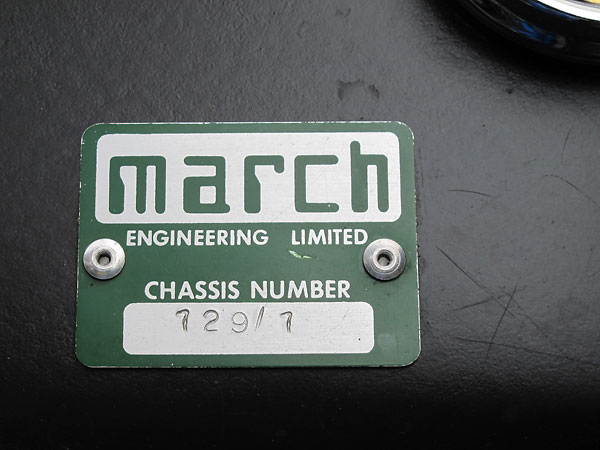
�
March Engineering Limited / Chassis Number 729/7
�
(U.K. constructed March racecars have blue chassis plates. Mitchell Engineering built Marchs have green ones.)
�
�
One small but interesting difference between U.K. produced March cars and the cars Mitchell Engineering�
built under contract is that the U.S. cars have green badges. Wayne Mitchell recalls making this choice as�
he was standing at the counter of the shop who would make them. Asked about color, he answered:�
"The color of money!"�
�
I asked Wayne to retrospectively analyze the March design. What were its strengths and weaknesses?�
Firstly, in Wayne's opinion the car's wedge-shaped nose was a giant mistake because it caused lift.�
The leading edge needed to be much closer to the ground. Secondly, the cars left Wayne's shop�
with bog-standard engines. Especially in California, there was a lot of cheating going on in Formula�
Ford. Stock engines were completely uncompetitive. Wayne felt the car's should have been offered�
with some sort of specially prepared engines so they'd at least have a chance. Thirdly, March didn't�
seed the market by getting a car into the hands of a really good driver. Had one hot shoe driver shown�
the car's potential, sales might have come easier and other good drivers might have won their own�
races. The car may have been a couple pounds heavy, but only a couple. Wayne remembers it�
as a good solid design, easily tunable and with a lot more potential than was demonstrated on track.�
�
The old saying goes "What wins on Sunday sells on Monday." There's a flip side to that coin.�
Unfortunately, Formula Ford production didn't turn out to be as lucrative as Mitchell hoped. He had a�
payroll to meet, and the vagaries of racecar sales made him uncomfortable. For that reason, Mitchell�
chose to focus on building up his machine shop. Nonetheless, in the thirty years since parting ways�
with March, Wayne Mitchell has never gotten away from racing. For example, Wayne Mitchell currently�
serves as tech inspector for two racing clubs: VARA and HSR-West. Mitchell Engineering has long�
been a favored supplier for specific precision racing parts including for example dog rings for racing�
gearboxes.�
�
Only a handful of spaceframe March racecars still exist, but Jim Johnson managed to save the last�
one - 729 number seven - from oblivion. He discovered and purchased it as a basket case,�
and has been able to document its provenance and complete its meticulous restoration with the help�
of Wayne Mitchell. Although U.K. records are sketchy, Mitchell has testified that Johnson's 729 is�
authentic: the last of a rare breed, beautifully presented and quicker than ever.�
�
�
IMPORTANT ANNOUNCEMENT
�
BritishRaceCar.com will have to cut back plans for continued growth if we can't find more financial support.
�
If you like what you've found here, and you want to see more, please click here and follow the instructions.
�
Readers like you keep BritishRaceCar.com online and growing through voluntary financial contributions.
�
Features and Specifications
�| Engine: | �Ford Kent 1600cc with iron cylinder head, rebuilt by Ivey Engines, Inc.�
Burton aluminum valve cover.�
Weber 32/36 DGAV carburetor.�
BAT throttle linkage.�
RamFX foam air filter.�
Bosch distributor.�
Bosch blue ignition coil.�
Taylor Spiro-Pro 8mm silicone spark plug wires.�
Unlabeled oil pump.�
Dry sump lubrication system.�
Peterson engine oil reservoir. | �
| Cooling: | �copper/brass crossflow radiator.�
Custom fabricated coolant swirl tank.�
| �
| Exhaust: | �custom four-into-one header from Ken Dye (DND). | �
| Transaxle: | �Hewland Mk8/9 4-speed, with reverse, in a Mk6 case with Webster side covers.�
Metalastic drive donuts. | �
| Front Susp.: | �unequal length wishbones.�
Alford & Alder forged uprights, with custom fabricated steering arms.�
KONI double-adjustable, steel-bodied coilover shock absorbers.�
Eibach coil springs.�
Adjustable 5/8" anti-sway bar.�
March proprietary steering rack. | �
| Rear Susp.: | �inverted lower wishbones, single top links, and twin radius arms.�
Proprietary March magnesium uprights.�
KONI double-adjustable, steel-bodied coilover shock absorbers.�
Eibach coil springs.�
Adjustable 9/16" anti-sway bar. | �
| Brakes: | �(master) dual Wilwood 5/8" master cylinders with integral reservoirs and adjustable bias bar. � (front) Girling 14LF calipers (casting# HDA21658). Triumph Spitfire solid rotors. � (rear) Girling 12SP calipers (casting# 64321547). Solid rotors (cross-drilled). | �
| Wheels/Tires: | �Revolution 4-spoke aluminum wheels (13x5.5).�
Dunlop Racing "Formula Ford" tires (135/545-13 CR82 front, 165/580-13 CR82 rear). | �
| Electrical: | �Odyssey battery (7.0kg)�
Lucas battery disconnect switch.�
Tilton Super Starter gear reduction starter.�
(No charging system.) | �
| Instruments: | �(left to right) Stewart Warner water temperature gauge (100-265F),�
Jones mechanical tachometer (1000-10000rpm),�
and Stewart Warner oil pressure gauge (0-100psi).�
| �
| Fuel System: | �Fuel Safe wedge-shaped, under-seat, aluminum fuel cell.�
AC mechanical fuel pump with push-on fittings. | �
| Safety Eqmt: | �OMP six point cam-lock safety harness.�
Mountney of Britain leather wrapped steering wheel, installed on a Troyer quick release steering wheel hub.�
Phoenix centralized fire suppression system. | �
| Racing Class: | �Formula Ford. | �
Engine Installation
��
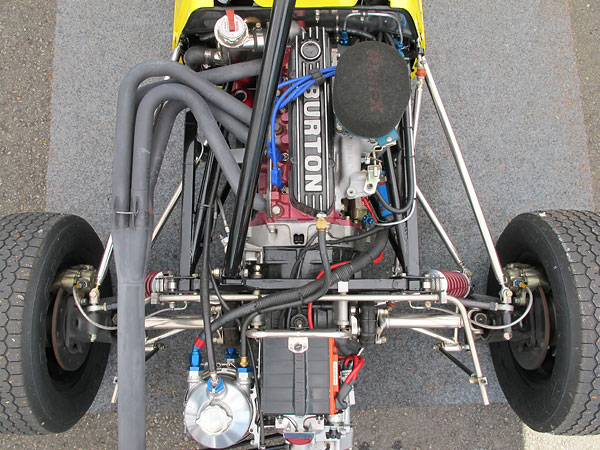
�
Ford Kent 1600cc with iron cylinder head, rebuilt by Ivey Engines, Inc. - Jim reports: "Jay Ivey does
�
all of the engine work and is a real prince. If he's at the track, he always drops by to see how things
�
are running. If something doesn't sound just right, he rolls up his sleeves and fixes it on the spot."
�
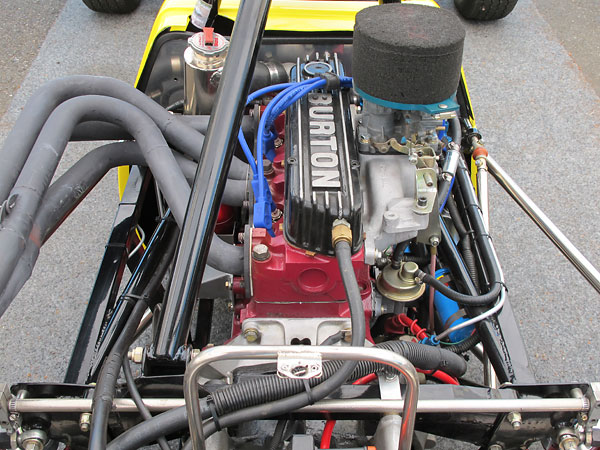
�
This Burton aluminum valve cover is a period accessory. Jim says it seals better than a steel cover.
�
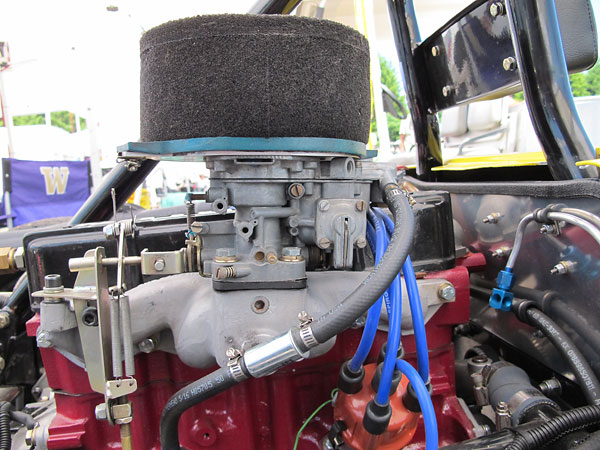
�
RamFX foam air filter atop a Weber 32/36 DGAV carburetor. BAT throttle linkage.
�
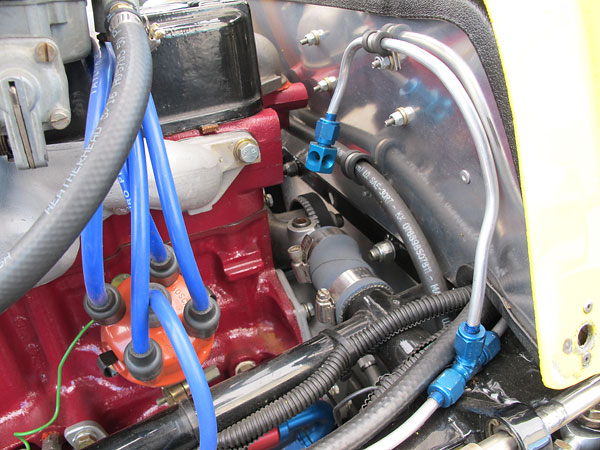
�
Bosch distributor with Taylor Spiro-Pro 8mm silicone spark plug wires.
�
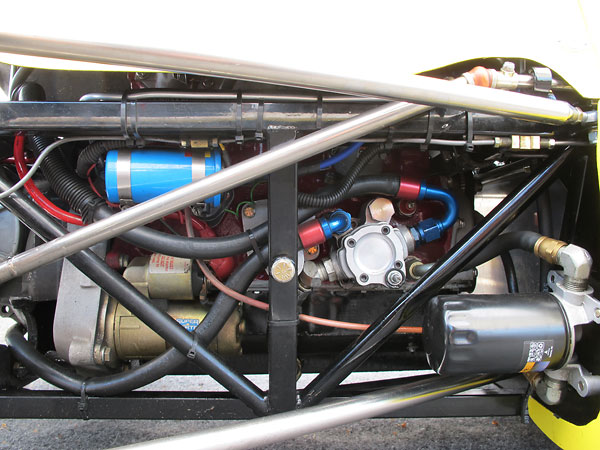
�
At left, Tilton Super Starter gear reduction starter. At right, Mitchell Engineering's very distinctive oil
�
filter mounting base. These bases were originally made for another of Wayne's businesses. Wayne
�
made and sold "Vari-Cam" kits for hot-rodders to update their American V8s with mechanically
�
variable camshaft timing. He still has inventory of old oil filter mounting bases if you need one.
�
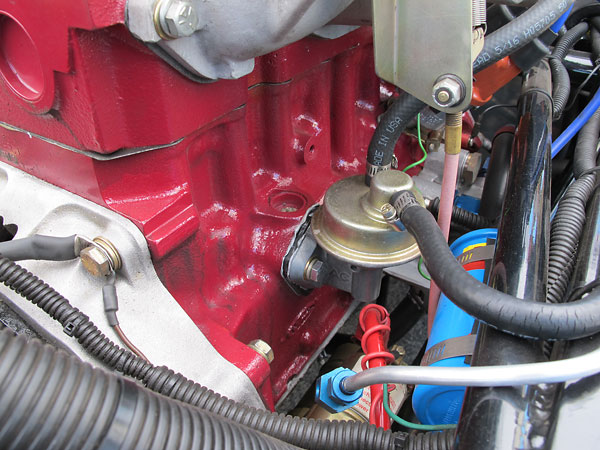
�
AC mechanical fuel pump with push-on fittings. At right: Bosch blue ignition coil.
�
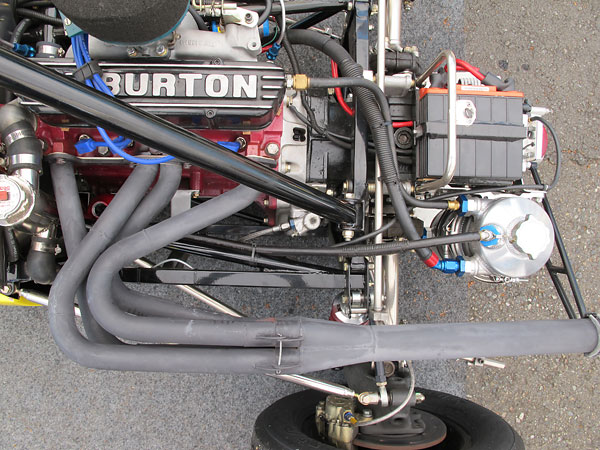
�
Ken Dye custom made this authentic looking copy of the original four into one exhaust header.
�
Wayne explained that only one example header was provided to him by March. He turned
�
it over to a fabrication shop in California and paid them to make duplicates for production.
�
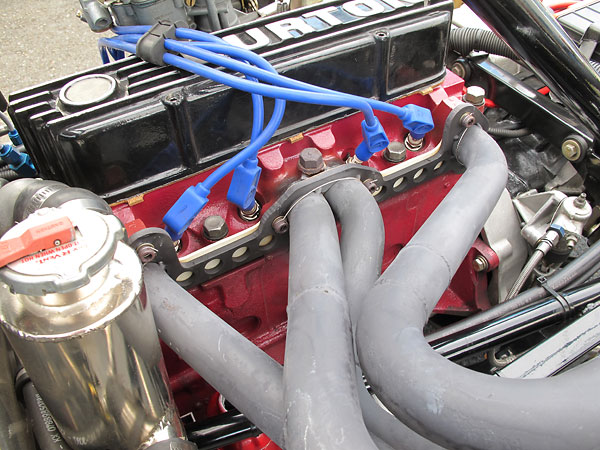
�
The header tubes were tack welded to the header flange at intervals on this side, and then welded
�
all the way around their circumferences on the cylinder head side.
�
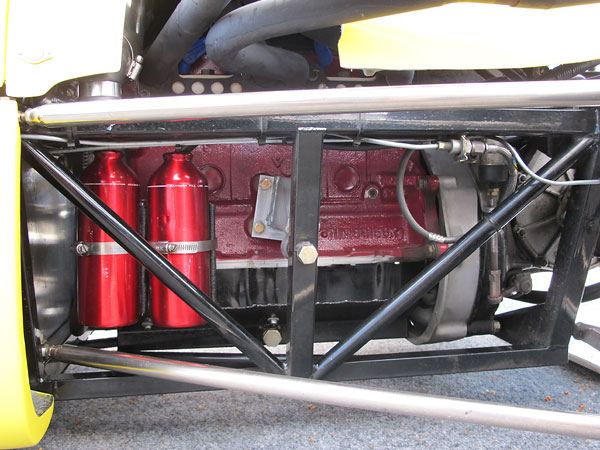
�
Casting number 711M6015BA indicates that this block is a 1600cc "tall" block with big bearing caps.
�
(Note: these motor mounts aren't the original style.)
�
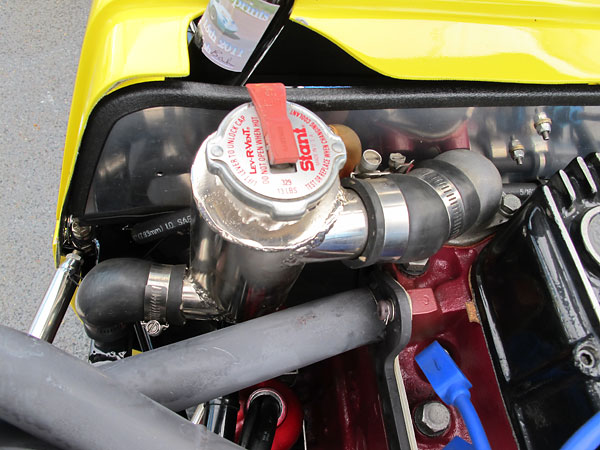
�
This is either an original Mitchell Engineering fabricated coolant swirl tank or an excellent replica.
�
The original swirl tanks were mild steel, brazed with nickel-bronze filler rod. How do they work?
�
the swirling of coolant helps entrapped steam bubbles escape to head space at the top.
�
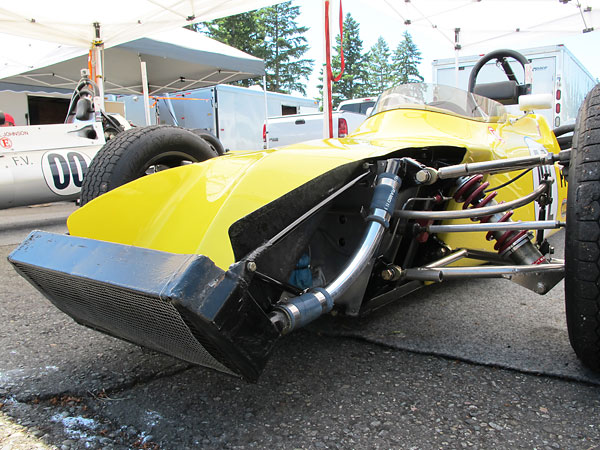
�
Graham Coaker was a Serck rep, so March always used Serck radiators on their UK produced cars.
�
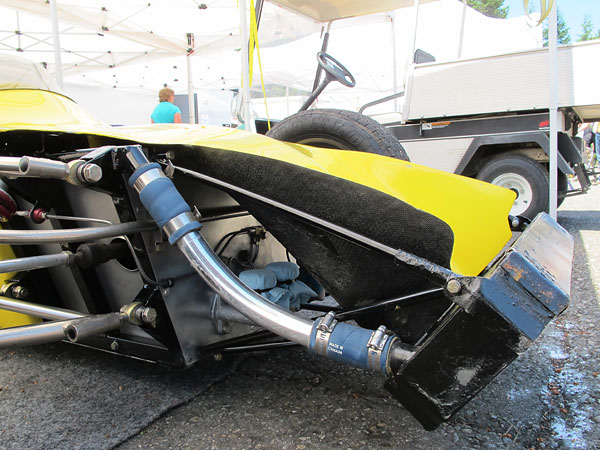
�
After the first few USA built cars, Mitchell Engineering sourced radiators from a local (California) shop.
�
In either case the radiators were similar in design, construction, and materials. The only easy way
�
to tell them apart would be to look for a Serck badge.
�
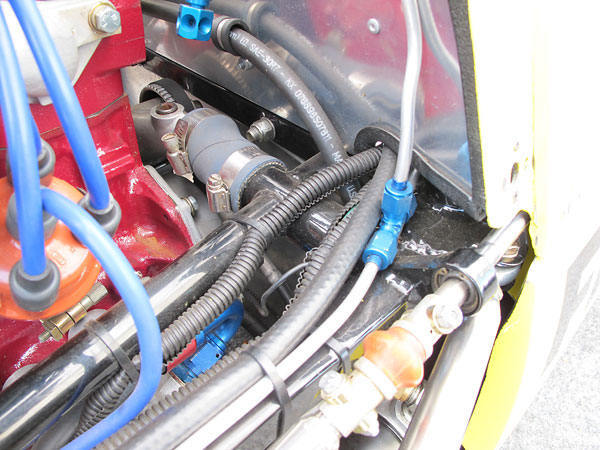
�
Hose connections between water pump and frame.
�
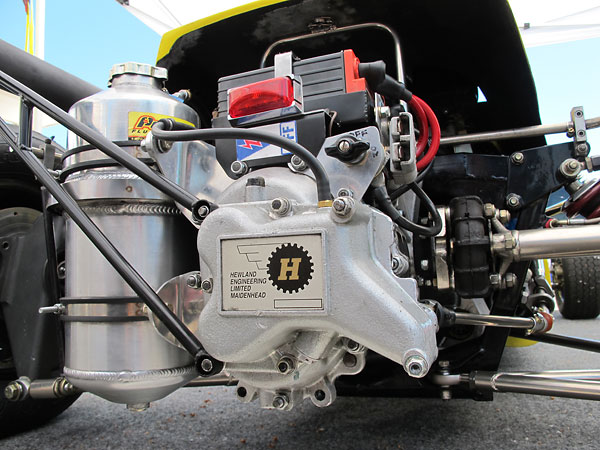
�
A new Peterson Fluid Systems engine oil reservoir is mounted by the transaxle, whereas March originally
�
put their oil tanks under the driver's seat. No engine oil cooler is installed! March never put one on, nor
�
recommended one. Jim has run this car eleven years without overheating and without any oil related
�
failures. He uses a special blend synthetic oil developed by Jay Ivey and a NAPA Gold oil filter.
�
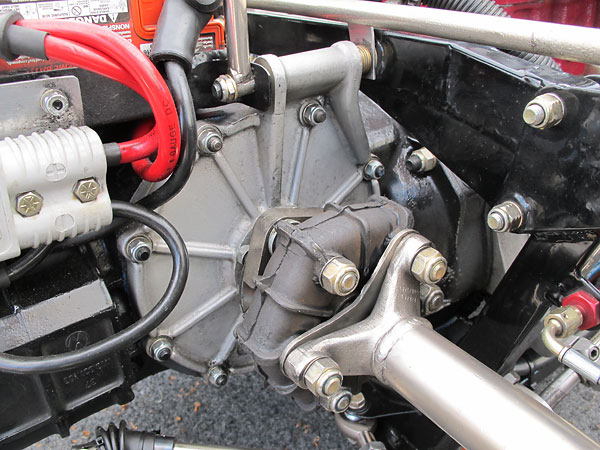
�
A thick steel adapter is installed so rubber donuts can be used in lieu of CV joints with these particular
�
transaxle output shafts. Class rules mandate rubber donuts, but appropriate drive flanges for installing
�
them are getting hard to find for Hewland Mk8 and Mk9 transaxles, so people use various adapters.
�
Not quite visible in this view, Jim explained one more important construction/preparation detail: "'I've
�
installed a set of Wayne's Donut Savers. They should really be called 'back end of your car savers'.
�
They work! I had a donut bolt failure and the joint stayed intact. I found the broken bolt after a
�
competitor mentioned that my halfshaft had a wobble on the cool down lap."
�
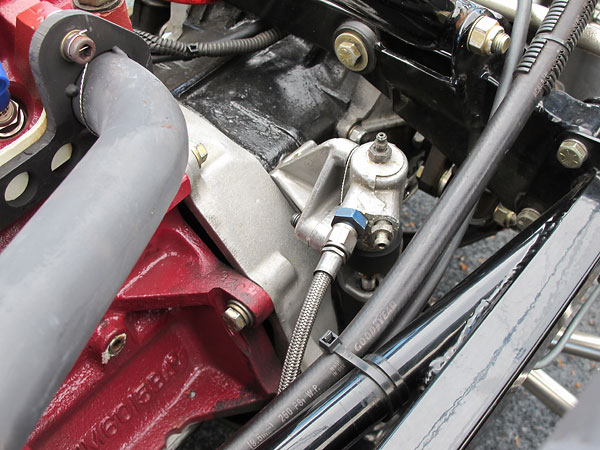
�
Notice that someone has added an extra bleed nipple to the end of this Girling clutch slave cylinder.
�
It's important to get all the air out of the system so the driver will sense a nice, firm pedal feel.
�
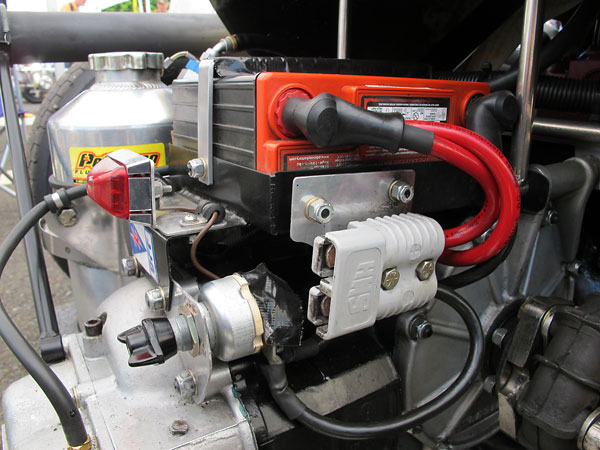
�
Odyssey battery (7.0kg), HMS jump start plug, and Lucas battery disconnect switch.
�
�
Front Suspension
��
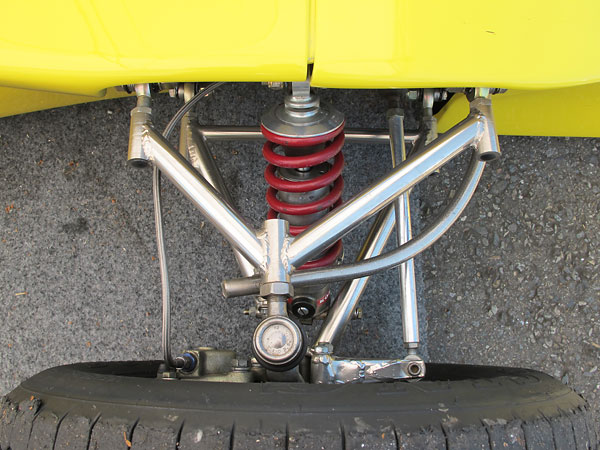
�
Koni steel-bodied double-adjustable shock absorber. March originally fitted Armstrong single-adjustable
�
shocks. On these Koni shocks, rebound dampening is adjusted at the narrow horizontal slot seen at the
�
top while compression is adjusted by a knob on the shocks' bodies. On Armstrongs, valves on the main
�
body are turned with a blade screwdriver to alter both rebound and compression characteristics at once.
�
(Mitchell Engineering still rebuilds Armstrong shock absorbers. Very few other shops do.)
�
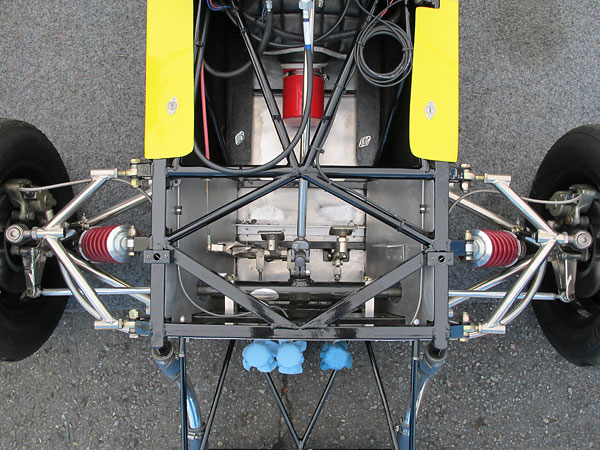
�
An interesting feature of the March design: the steering rack is located rearward of the front bulkhead.
�
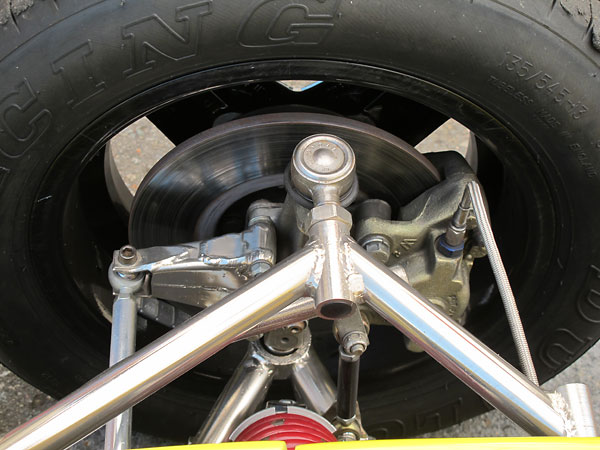
�
The steering rack lines up with uncommonly short steering arms. The March design called for specially
�
fabricated steering arms instead of the off-the-shelf parts most other Formula Ford constructors used.
�
Certainly all the 719 and 729 cars had them. Result: quicker steering.
�
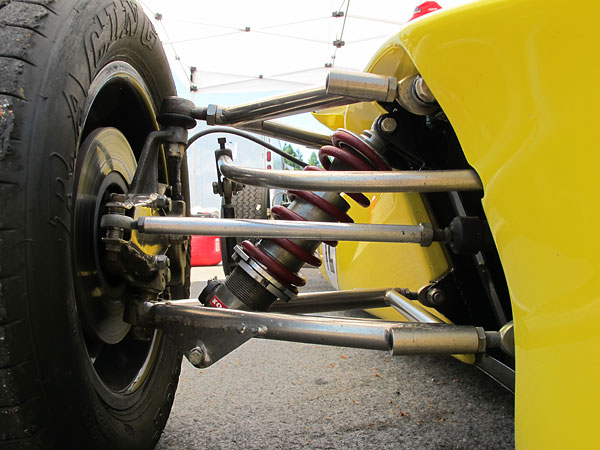
�
March's custom fabricated steering arms put the Heim joints in double shear (a very good thing) and
�
also made attachment height more readily adjustable so bump steer could easily be tuned out.
�
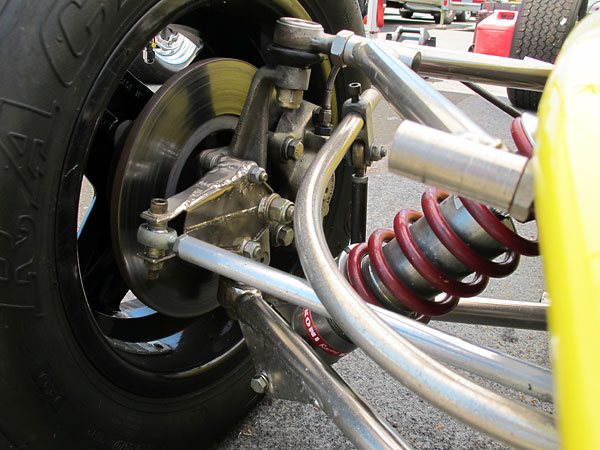
�
Wayne Mitchell made a variety of anti-sway bars for the March Formula Fords, all fabricated in house, and
�
all featuring big sweeping curves instead of small radius bends. (This bar appears to be "original".)
�
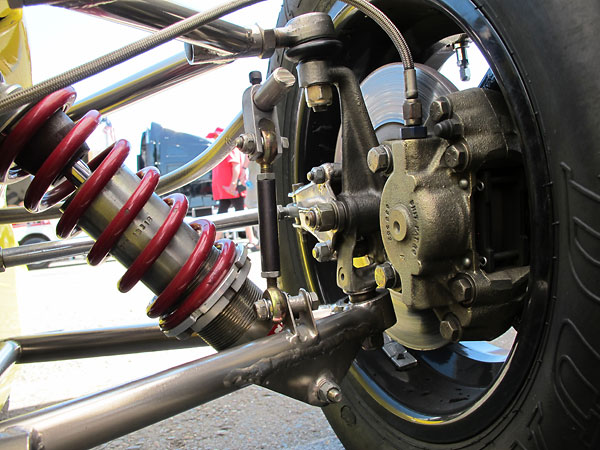
�
Girling 14LF calipers (casting# HDA21658). Solid rotors.
�
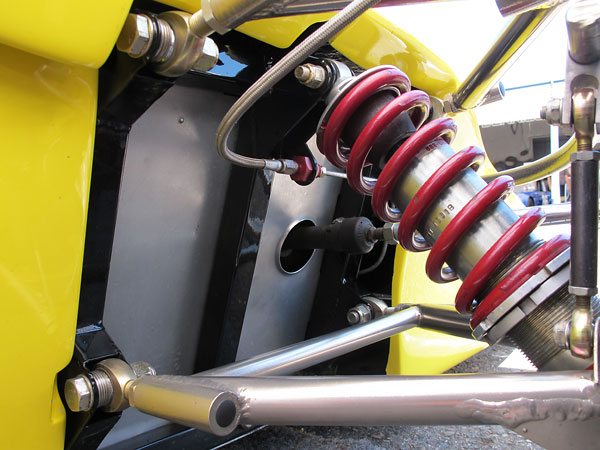
�
These are steel-bodied shock absorbers. An otherwise identical but lighter weight aluminum-bodied
�
version is available, but is explicitly prohibited for the vintage Formula Ford racing by most clubs.
�
(In Jim's club, the aluminum bodied version would be allowed for the Formula B class.)
�
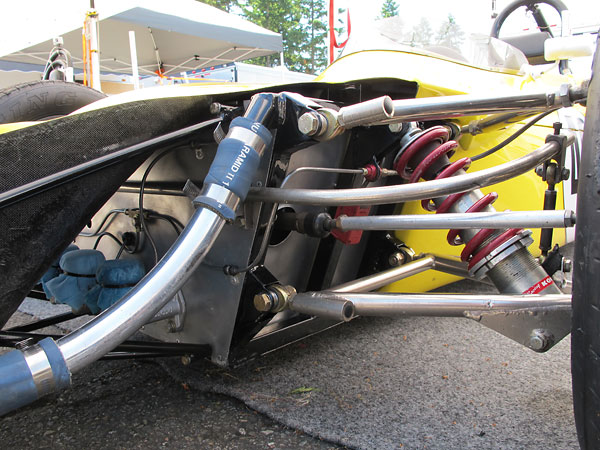
�
A portion of shock absorber mass moves up and down with the wheel. In other words: it's unsprung weight.
�
Racers put special value on reducing unsprung mass because it disproportionately affects tire grip (as well as
�
ride quality.) Generally, aluminum shocks also dissipate heat better, for more consistent performance.
�
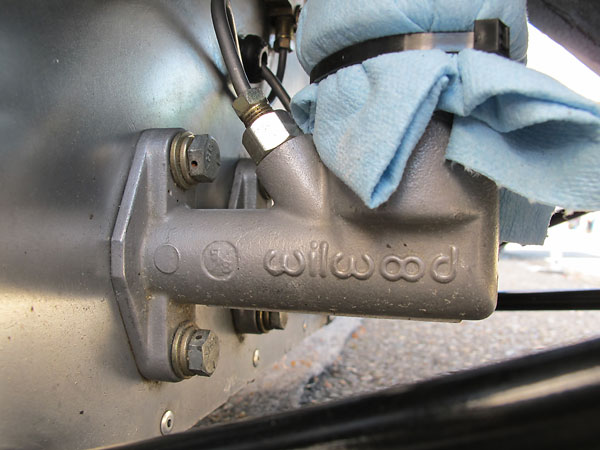
�
Wilwood replacement brake master cylinder. (This one is marked "5/8", which is its bore diameter.)
�
�
Enjoying this article? www.BritishRaceCar.com is partially funded through generous support from readers like you!
�
To contribute to our operating budget, please click here and follow the instructions.
�
(Suggested contribution is twenty bucks per year. Feel free to give more!)�
Rear Suspension
��
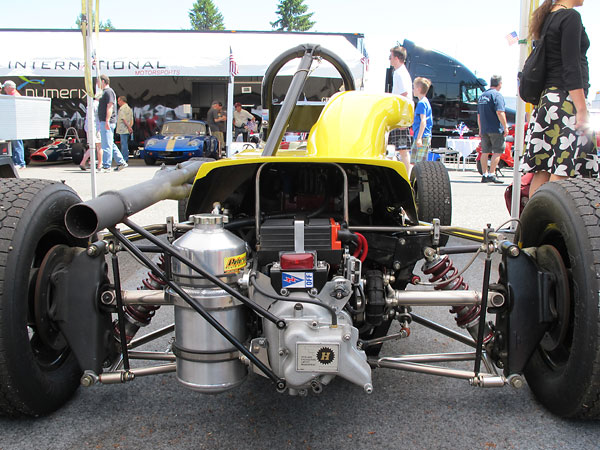
�
Note that March had their own distinctive magnesium uprights.
�
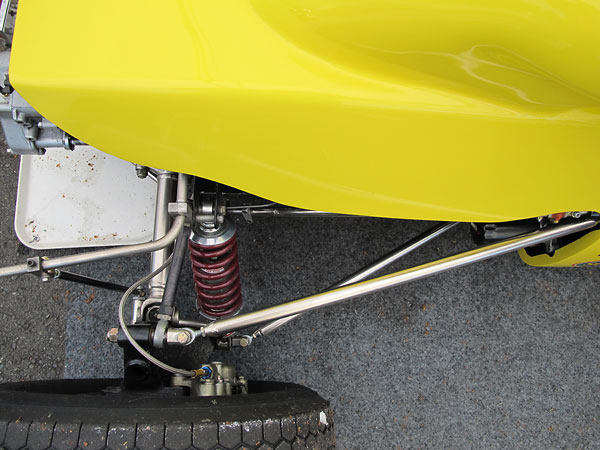
�
What made Mitchell Engineering built March Formula Fords different from the earlier UK-built version?
�
One difference was plumbing: Mitchell Engineering installed Aeroquip stainless steel braid reinforced
�
hoses in lieu of simple rubber hoses.
�
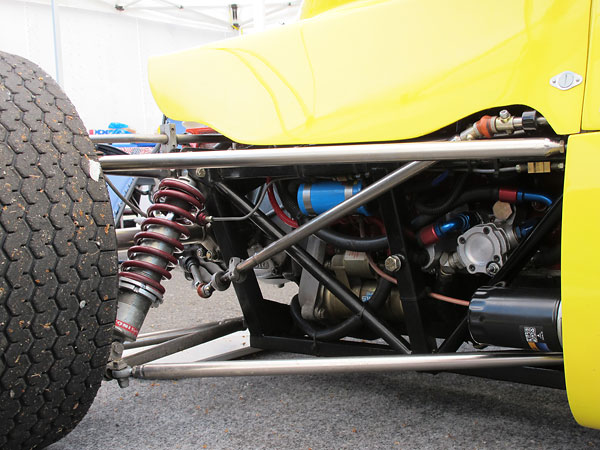
�
The shifter linkage is routed high as it passes the engine bulkhead to provide clearance to the original
�
fuel cell placement. March's F3 cars had dual fuel cells, one under each of the drivers elbows. March
�
Formula Fords were built with similar cells, placed on either the left or right side. (Production varied.)
�
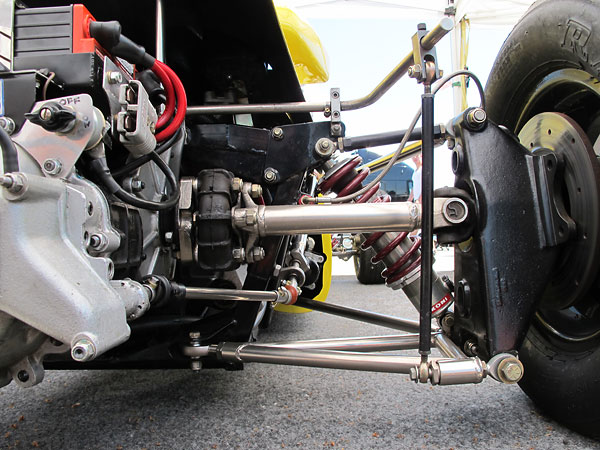
�
Wayne equipped 719 and 729 Formula Fords with a distinctive clamp of his own invention which made
�
their shifter linkages infinitely adjustable in both length and rotation. It's a split-block design, and in
�
this view it can be seen just beyond the Heim joint which is in turn just beyond an Apex u-joint.
�
Wayne still offers these clamps, and they've been retrofitted to many other Formula Fords.
�
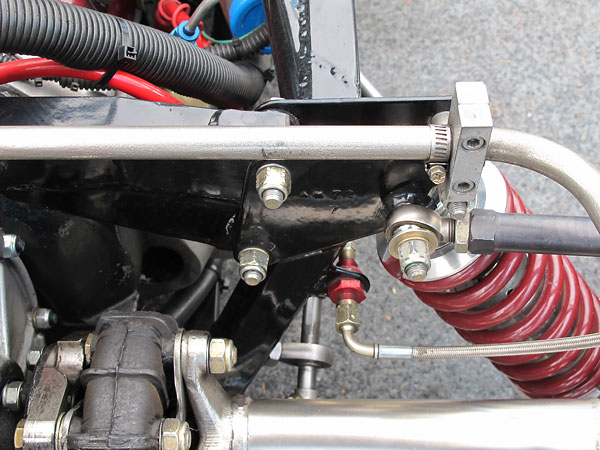
�
The frame appears to be stamped "AM 72 7" - but don't be fooled. This isn't an Arch Motors constructed
�
frame. All fourteen 719 and 729 Marchs had frames fabricated by Wayne Mitchell in California. Wayne
�
stamped his own initials and the date of manufacture into the rear lefthand (not righthand, as shown here)
�
corner of the frame. Most 729 frames were actually assembled in 1971, and were therefore stamped "71".
�
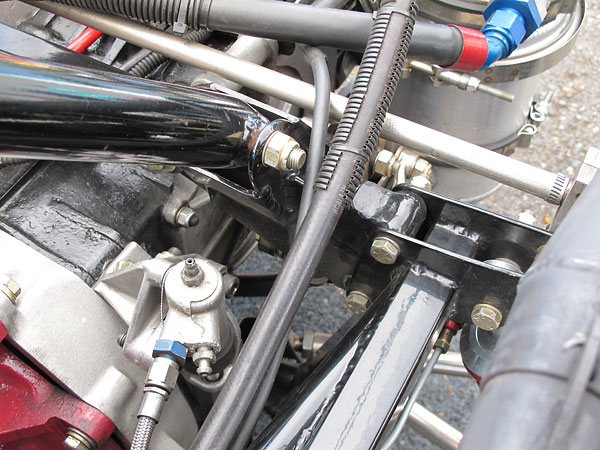
�
Rear crossmember and roll hoop brace connections.
�
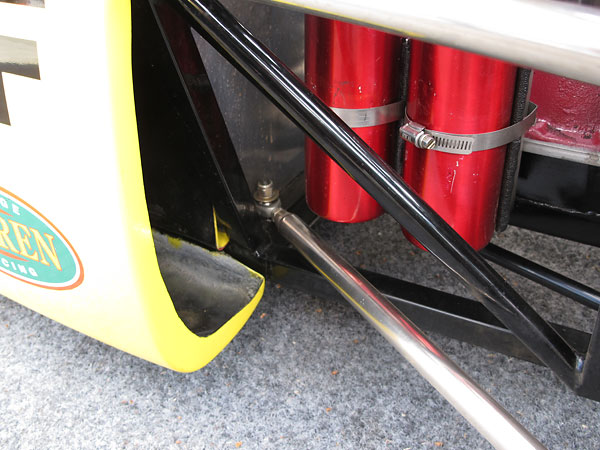
�
Lower trailing link connection to the frame.
�
�
Interior
��
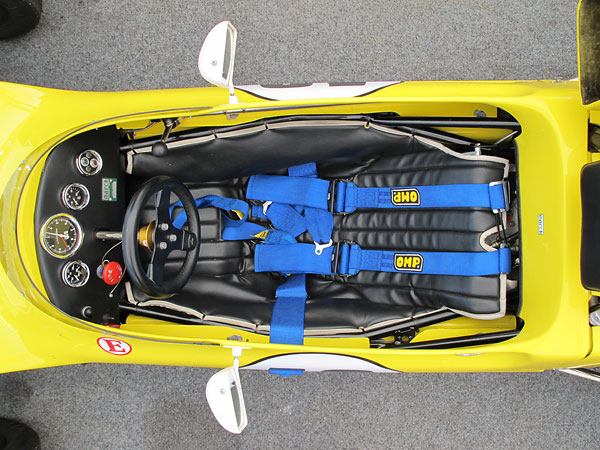
�
A comfortable and attractive custom drivers seat.
�
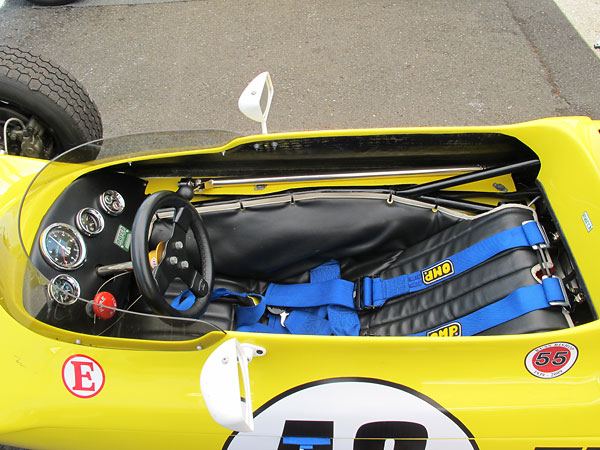
�
OMP six point cam-lock safety harness.
�
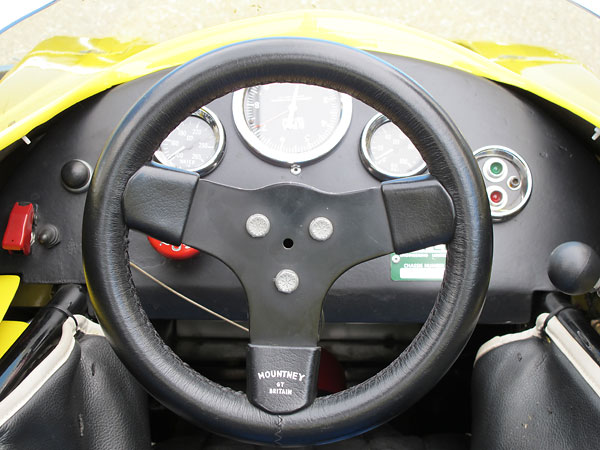
�
Mountney of Britain leather wrapped steering wheel.
�
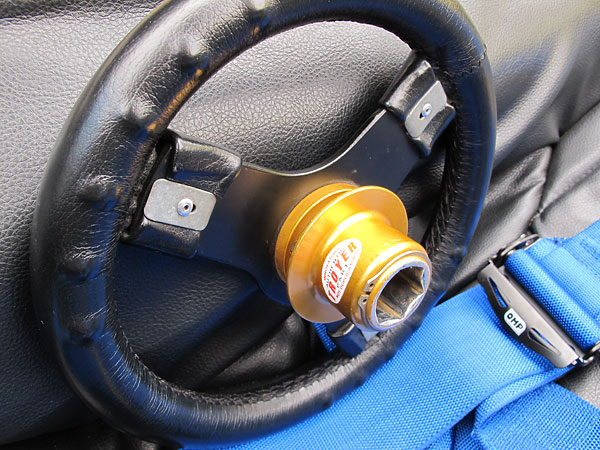
�
Troyer quick release steering wheel hub. The label says: "Innovation, not duplication."
�
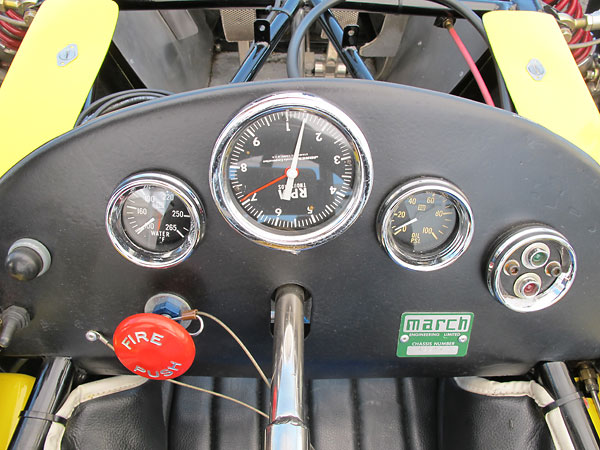
�
Stewart Warner water temperature and oil pressure gauges, and Jones mechanical tachometer.
�
Back in the day, March supplied Mitchell Engineering with Smiths tachometers. However, Mitchell
�
bought Stewart Warner coolant temperature and oil pressure gauges locally. When restoring the
�
car, Jim contacted Wayne Mitchell to see if he might borrow an original dashboard template, and
�
instead Wayne mailed him a spare, original aluminum dashboard.
�
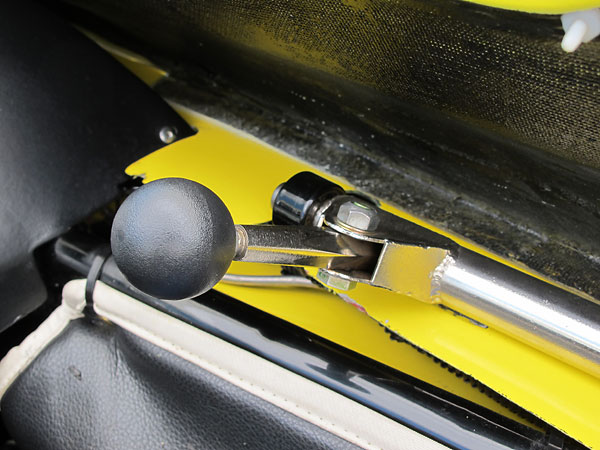
�
Close-up view of the gear selector mechanism.
�
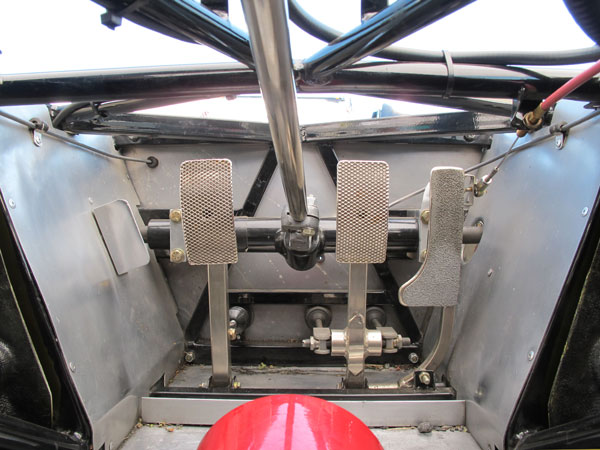
�
Floor mounted pedals. March used similar pedals for Formula 3. Note also the heel bar and dead pedal.
�
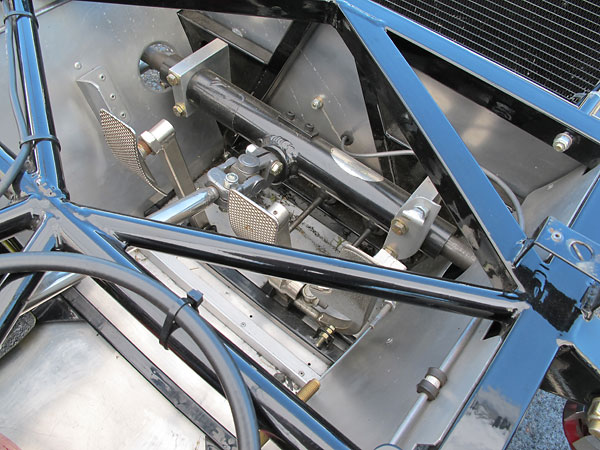
�
Mitchell Engineering racks are very distinctive. Whereas UK-built (Jack Knight et al) steering racks
�
typically featured cast magnesium or aluminum housings, Mitchell Engineering fabricated racks
�
from heavy wall aluminum tubing, heliarc welded and then finally either silver or black anodized.
�
(Mitchell Engineering still offers custom made racks constructed by this method.)
�
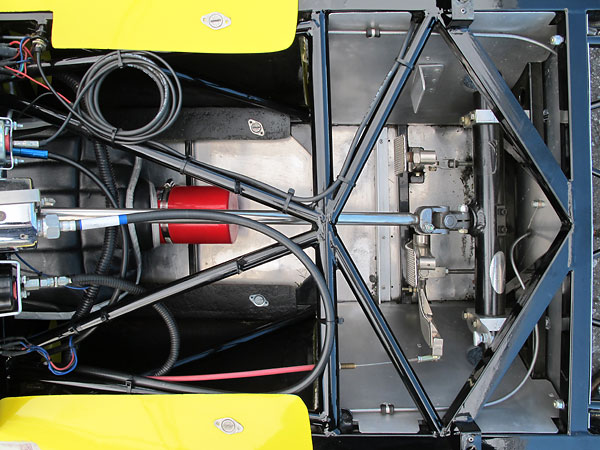
�
March's Formula Ford frames were stiff, if a little on the heavy side. They were constructed from
�
a pragmatic mix of round and box section steel tubing. (Note the coolant sensor bung at upper left.)
�
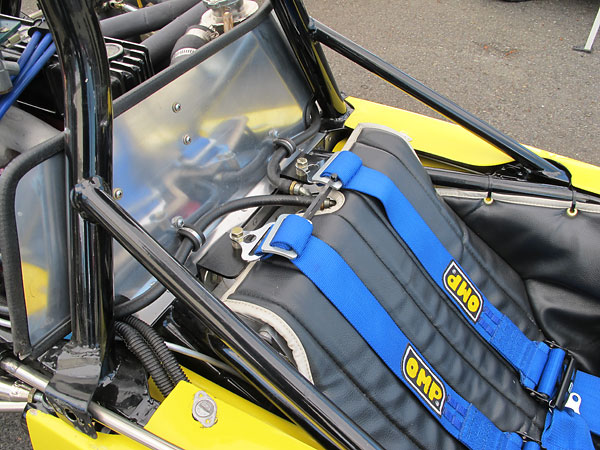
�
Updated details: roll hoop construction, shoulder harness attachment, and plumbing for under-seat fuel cell.
�
March provided each Formula Ford with one foam-filled rubber fuel bladder mounted under a side-pod
�
(usually on the right side), protected only by fiberglass bodywork. An engine oil reservoir was mounted
�
behind the drivers back. One consequence of this approach was additional heat in an already warm
�
cockpit so Jim decided to install a new Peterson oil tank out back by the transaxle. This freed-up
�
room for installing a new wedge-shaped Fuel Safe fuel cell behind the drivers seat.
�
�
Exterior
��
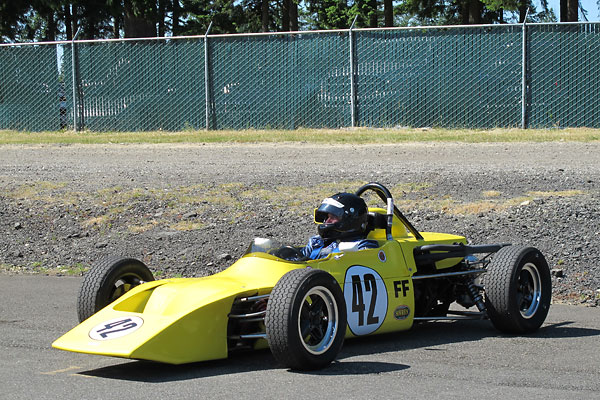
�
Jim Johnson acquired this rare March Formula Ford as a basket case. Between 1971 and '72,
�
fourteen of these cars were made for March by Wayne Mitchell (d.b.a. Mitchell Engineering)
�
in Southern California. The design and many of the parts were provided by March's workshop
�
in England. Mitchell produced frames, bodies, and many other fabricated and machined parts.
�
When March sold Formula Fords to American customers, Mitchell drop-shipped the cars.
�
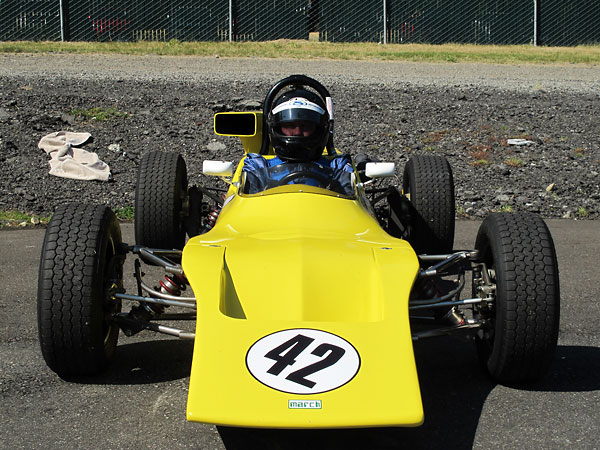
�
The car's body was missing when Jim got it, so he borrowed bodywork from another March 729 owner.
�
From the five borrowed body parts, Frank Martinez made new molds and replacement body panels.
�
Frank Martinez also made a spare body panel set for Wayne Mitchell.
�
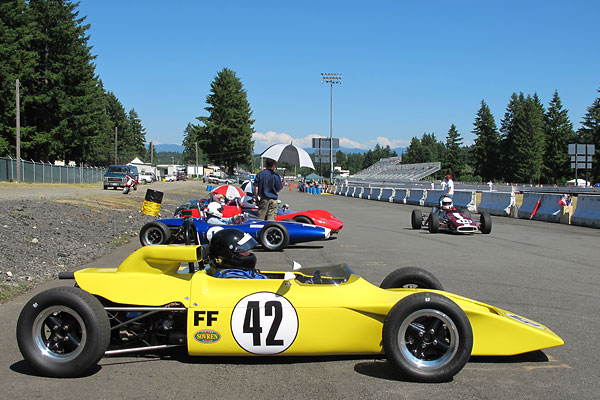
�
Mitchell Engineering didn't provide engine covers on the March Formula Fords they produced, but
�
this car had one when Jim bought it. The original source of his cover is unknown, but because of the
�
engine cover Jim believes his car is probably the same March 729 shown in Steve Nickless' book,
�
"The Anatomy and Development of the Formula Ford Race Car". (March's early UK-produced cars
�
came with engine covers, but they were shaped differently.)
�
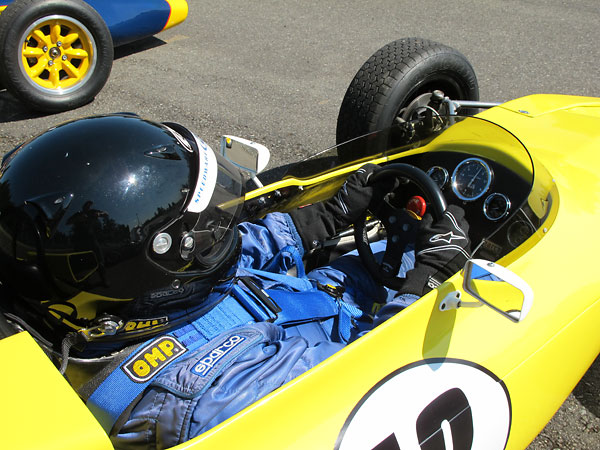
�
Jim and his daughter are big fans of Douglas Adams, including his "Hitchhikers' Guide to the Galaxy".
�
When they needed to select a racing number, "42" seemed the right choice.
�
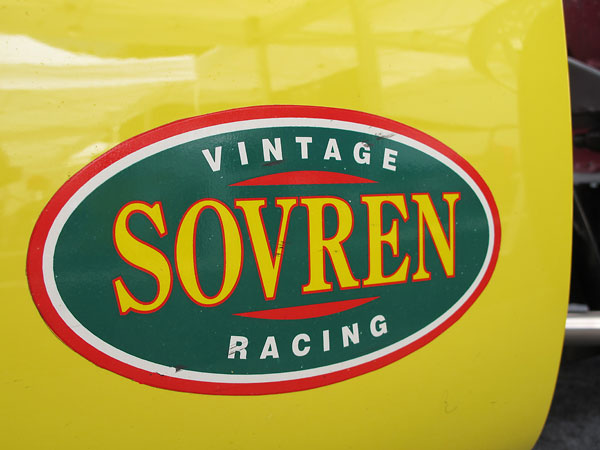
�
SOVREN (Society of Vintage Racing Enthusiasts in the Northwest) Vintage Racing
�
Jim wrote: "Al Murray, a fellow SOVREN open wheel racer and past club President was a great
�
mentor. He talked me through the restoration process when I first got the car 12 years ago."
�
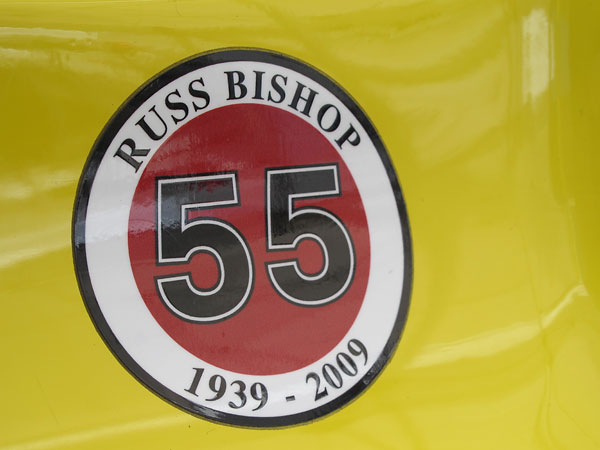
�
55 - Russ Bishop - 1939-2009
�
(Russ raced a Formula Ford in SOVREN events over several years.)
�
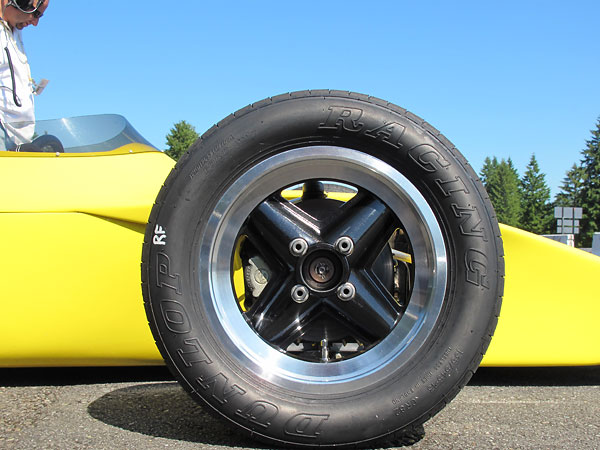
�
Revolution 4-spoke aluminum wheels (13x5.5). By 1972, aluminum or magnesium wheels would
�
have been allowed on Formula Fords anywhere they raced in the United States. (Not so in the rest
�
of the world!) Nonetheless, all March Formula Fords were sold with steel wheels. The performance
�
difference is large, so any serious racer would certainly have upgraded. SOVREN generally follows
�
"Monoposto" rules, but they've made a specific exception to allow aluminum wheels.
�
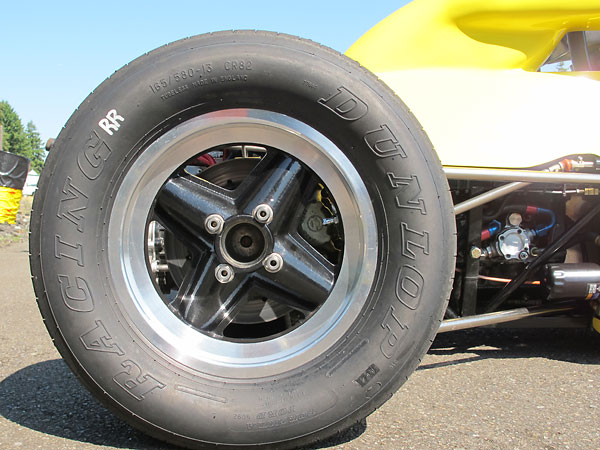
�
Dunlop Racing "Formula Ford" tires (135/545-13 CR82 front, 165/580-13 CR82 rear).
�
| Notes: | |||||||
| (1) | �
Per racecar historian Chris Townsend, March's 1971 Formula Ford production was as follows:�
� 718-1: a rebuild of chassis 708-6 for employee Bill Stone's personal use. � 718-2: a rebuild of chassis 708-5 for Colin Andrews, UK. � 718-3: for Chris Tipping, UK. By 1976 this car was being raced in UK by Willie Moore. � 718-4: for Andrew Chatburn, UK. � 719-1: for Gordon Dewar, CA. � 719-2 (frame AM71-5): for Ric Forest, CA. � 719-3 (frame AM71-11): Tom Johnston, CA.� � Per Wayne Lee who currently owns 719-2, March updated the design of the cigar noses on� UK-produced 719s from previous models by adding a NACA-style duct forward of� the instrument panel.� | ||||||
�
Unless otherwise noted, all photos shown here are from June 2011 when we viewed this car�
at The Pacific Northwest Historics at Pacific Raceways in Kent, Washington.�
All photos by Curtis Jacobson for BritishRaceCar.com, copyright 2011.�
All rights reserved.
�
| If you liked this article, you'll probably also enjoy these: | �|||||
 | �
Howard Freeman 1968 Merlyn 11 | �
 | �
Scott Fairchild 1972 Royale RP3A | �
 | �
Gord Leach 1974 Hawke DL11 | �
| You're invited to discuss anything you've seen here on The British Racecar Motorsports Forum! | �|||||
�
Notice: all the articles and almost all the photos on BritishRacecar.com are by Curtis Jacobson.
�
(Photos that aren't by Curtis are explicitly credited.) Reproduction without prior written permission is prohibited.
�
Contact us to purchase images or reproduction permission. Higher resolution images are optionally available.
�

 �
�